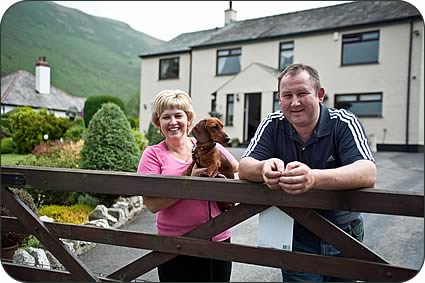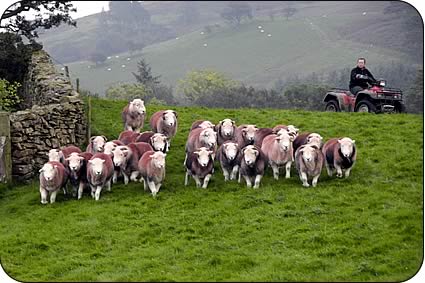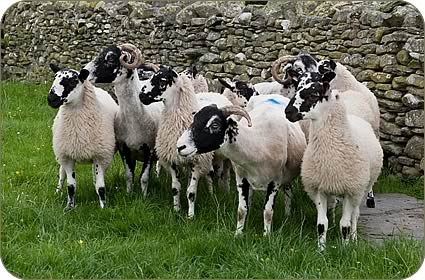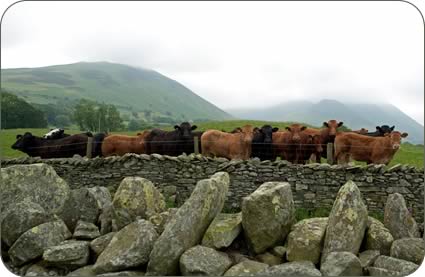Jennifer MacKenzie is an agricultural photo journalist with almost 30 year's experience. Operating from her base in Cumbria, Jennifer undertakes mainly industry-related freelance writing and photography.
Science saves the hardy Herdwicks
Breeding Herdwick sheep has been in the family for generations for Andrew
and Karen Nicholson.
When they started farming at Swinside End, High Lorton, near Cockermouth,
in 1996 they established their own Bank Fell flock from Herdwicks from
Andrew’s grandfather Gordon Stagg and Karen’s grandfather Jack
Bland, who both farmed in Buttermere.
Such was the quality of Gordon Stagg’s flock that he broke the record
in the 1970s when he sold a ram for £100.
 |
| Karen and Andrew Nicholson with Dachshund Frankie |
In 2001’s foot and mouth epidemic the Nicholsons were fortunate
to save some of the flock’s bloodlines from the contiguous cull,
thanks to Prof Dianna Bowles of the University of York and The Heritage
GeneBank, set up during the crisis to protect the UK genetic biodiversity
of sheep breeds.
The project attracted funding which enabled semen to be taken from one
of the Nicholson’s home-bred Herdwick rams which was used for the
first time last autumn and six lambs - one ram and five females - were
born in May along with another six lambs from embryos.
During the crisis, a vet managed to persuade Defra of the importance of
the breed and the Bank Fell bloodlines and and Nicholsons were able to
keep 40 of their ewe.
Now numbers have reached those pre-foot and mouth at 400 ewes, bred from
the sheep that were saved, supplemented by bought in sheep from leading
breeder, Anthony Hartley, of Turner Hall, Seathwaite, Broughton-in-Furness.
Herdwicks bred by the Nicholsons have sold for £3,000 at Cockermouth
for a home bred shearling ram in 2009. A firm believer in the live ring,
Andrew is a director of Mitchells Auction Company in Cockermouth.
They also fly the flag for the breed and hope to be able to show some of
the AI lambs at Borrowdale Show, the ‘Herdwick Royal’ in September.
 |
| Herdwicks Photo by David Stephenson |
The Nicholsons farm 1,000 acres of owned and rented SDA ground as well
as 250 acres of enclosed common on Bank Fell.
They have a flock of 1,000 Swaledale ewes which run on Braithwaite Common,
which are bred pure and also crossed with the Bluefaced Leicester to produce
replacements for their 200-ewe North of England Mule ewe flock.
At last year’s NEMSA show and sale at Cockermouth mart, Mule gimmer
lambs averaged £101 a head and collected second and fifth prize tickets.
Replacement Bluefaced Leicester rams have been bought in from John Lord,
of Dowgill, Stainmore, although with flock numbers for the crossing type
of Leicester now at 15 ewes, Andrew hopes to have some rams of his own
to sell.
Swaledale stock tups are bought locally, mainly from Keith Ireland, of
Stockhow, Ennerdale.
The Mules are crossed with the Texel, with some ewe lambs retained for
crossing with the Blue Texel.
 |
| Swaledale ewes with Mule lambs |
Lambing begins on March 1 with the Mule and Texel crosses, followed by
the Swaledales crossed with the Leicester on March 20 and the fell Swaledales
in mid-April.
All the lambs are sold finished through Cockermouth, with Mule-Texel crosses
last year averaging £70, Texel cross Blue Texel crosses at £89
and Herdwick wethers making £75.
The farm also carries a herd of 50 Limousin cross and British Blue cross
suckler cows, all put back to the Limousin bull. Some replacements are
home-bred for the spring and autumn-calving herd.
Calves are sold at nine to 10 months old through Cockermouth from January
to May. Calves have sold to a top of £4,000 for a heifer two years
ago.
Heifers this year won the championship at the March show, selling at £2,200
with anothr heifer at £1,900. Both were by pedigree stock bull Keskadale
Vigo, bought from Keith Harryman, of Newlands, Keswick. A second stock
bull, Edmo Barbecue bred by Sarah Edmondson, of Wigton, has also been breeding
well.
 |
| Limousin cross suckled calves |
Ten years ago Karen began taking in bed and breakfast guests at Swinside
End and such was the success of the venture that they extended the house
to provide a fourth bedroom and guest dining room.
The three double and one twin, en-suite rooms and the high standard of
accommodation and service has earned a five star silver award from the
English Tourist Board.
While crossed by the Coast to Coast Cycle Route, the Lorton Valley is quieter
than other parts of the Lake District and Swinside End makes an ideal base
to tour the western Lakes or from which to go east to Keswick and the heart
of the popular tourist region.
The bed and breakfast business is mainly Karen’s domain - from the
tasteful decor in the house to the immaculate gardens which overlook the
valley and the fells beyond - Andrew dons his apron each morning to fry
the eggs and make the toast for the guests’ breakfast!
Also popular with farmers visiting the area for sales, the accommodation
can be seen on the website at www.swinsideendfarm.co.uk

